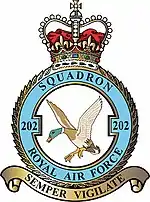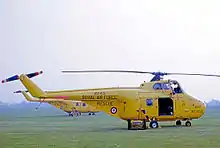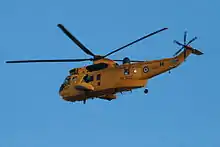| No. 202 Squadron RAF | |
|---|---|
 | |
| Active | Royal Naval Air Service 17 October 1914 – 1 April 1918 Royal Air Force 1 April 1918 – 22 January 1920 9 April 1920 – 16 May 1921 1 January 1929 – 12 June 1945 1 October 1946 – 31 July 1964 1 September 1964[1] – 18 February 2016
|
| Country | |
| Branch | |
| Type | Flying squadron |
| Role | Search and rescue training |
| Part of | Defence Helicopter Flying School |
| Home station | RAF Valley |
| Motto(s) | Semper vigilate (Latin for 'Be Always Vigilant')[2][3] |
| Aircraft | Airbus Helicopters Jupiter HT.1 |
| Commanders | |
| Current commander | Squadron Leader Simon Allen |
| Insignia | |
| Squadron badge heraldry | A mallard alighting. Approved by King George VI in March 1937.[2][3] |
| Squadron codes | JU (Allocated Apr 1939 – Sep 1939, no evidence of use)[2][4] TQ (Sep 1939 – Aug 1943)[5] AX (May 1941 – Aug 1943)[6] TJ (Jul 1944 – Jun 1945)[7] Y3 (Oct 1946 – Apr 1951)[8] A (Apr 1951 – 1956)[9] |
No. 202 Squadron of the Royal Air Force is the maritime and mountains training element of the No.1 Flying Training School, operating the Airbus Helicopters H145 Jupiter.[10]
It previously operated the Sea King HAR3 in the search and rescue role at three stations in the northern half of the United Kingdom. It was originally formed as one of the first aeroplane squadrons of the Royal Naval Air Service (RNAS) before it became part of the RAF.
History
Formation and the First World War
No. 202 Squadron was formed along with the entire RAF on 1 April 1918 by renumbering No. 2 Squadron of the Royal Naval Air Service (RNAS).[11] It was originally formed as one of the first aeroplane squadrons of the RNAS on 17 October 1914.[2][12] It served on the Western Front during the First World War, carrying out reconnaissance and bombing missions from bases in Belgium and France before being disbanded on 22 January 1920.[3][12]
The interbellum
The squadron was reformed for a brief period between 9 April 1920 and 16 May 1921 as a fleet co-operation unit.[2] In 1929, it was reformed when No. 481 Flight, operating the Fairey III floatplane in Malta was re-numbered as No. 202 Squadron, continuing to fly patrols over the Mediterranean Sea throughout the 1930s, being re-equipped with Supermarine Scapa flying boats in 1935.[3][13]
Second World War
During the Second World War, the squadron flew anti-submarine patrols from RAF Gibraltar with Saro London, Consolidated Catalina and Short Sunderland flying boats and Fairey Swordfish torpedo bombers until 1944, when it moved with its Catalinas to RAF Castle Archdale, Northern Ireland, disbanding there on 12 June 1945.[3][13]
Post-war
Weather Reconnaissance

No. 202 Squadron was reformed by the re-numbering of No. 518 Squadron[1] as a weather reconnaissance squadron at RAF Aldergrove near Belfast on 1 October 1946, flying converted Handley Page Halifax GR.6 & A.9 bombers on long-range meteorological flights over the North Atlantic (codenamed "Bismuth"). It re-equipped with the more modern Handley Page Hastings Met.1 from November 1950, continuing in this role until disbanding on 31 July 1964.[3][14]
Search and Rescue
Reformed on 1 September 1964[3] by the renumbering of No. 228 Squadron at RAF Leconfield in Yorkshire, the squadron began operating in a new helicopter search and rescue role using the Westland Whirlwind HAR.10, with flights based at RAF Acklington and RAF Ouston in Northumberland, RAF Coltishall in Norfolk and RAF Leuchars in Fife. The squadron moved to RAF Finningley during September 1976 with flights at RAF Boulmer in Northumberland, RAF Leconfield, RAF Coltishall, RAF Lossiemouth in Moray and RAF Brawdy in Pembrokeshire. The squadron re-equipped with Westland Sea King HAR3 from July 1978, but operated the Westland Wessex HAR2 as an interim measure whilst its Sea Kings were involved in the Falklands War of 1982.[15] On the closure of Finningley in 1989 the squadron moved its headquarters to Boulmer and later in April 2008 to RAF Valley in Anglesley.[11]

The primary role of RAF search and rescue was the recovery of downed military aviators, however in peacetime, its aircraft were available for use in civilian distress incidents. Over 95% of the rescues carried out by the squadron were civilian incidents. Rescues included a wide variety of incidents involving casualties from aircraft, fishing trawlers, ferries, oil rigs, mountainous terrain, cliffs and the waters surrounding the UK.[16]

In 2006, the government announced its intentions to privatise the search and rescue helicopter service in the UK. A ten-year contract worth £1.6 billion was signed in March 2013 with Bristow Helicopters who would run the service from 2015 with new AgustaWestland AW189 and Sikorsky S-92 helicopters. SAR helicopter operations ceased in staged handovers from March through September 2015.[17] 'A' Flight at Boulmer ceased flying in October 2015,[18] 'B' Flight at RAF Leconfield in March 2015[19][20] and 'D' Flight at Lossiemouth in April 2015.[21]
Reformation
.jpg.webp)
In May 2016, the Search and Rescue Training Unit (SARTU) was renumbered 202 Squadron[22] as the maritime and mountains training element of the Defence Helicopter Flying School based at RAF Valley and operating the Bell Griffin HT1 helicopter.[10] After a brief pause in operations in January 2018, No. 202 Squadron was again reformed in March 2018 as the 'maritime and mountains' training Squadron of the DHFS (a UK MFTS venture) and re-equipped with the Airbus Jupiter HT1.[23]
Aircraft operated
- Royal Aircraft Factory B.E.2
- Avro 504
- Bristol Scout
- Nieuport 17
- Sopwith Pup
- Sopwith 1½ Strutter
- Farman F.40
- Short 184
- Airco DH.4
- Airco DH.9
- Fairey IIID
- Fairey IIIF
- Supermarine Scapa
- Saro London
- Consolidated Catalina
- Fairey Swordfish
- Short Sunderland
- Handley Page Halifax
- Handley Page Hastings
- Westland Whirlwind
- Westland Sea King
- Westland Wessex
- Bell Griffin HT1
- AgustaWestland AW139
- Airbus Jupiter HT1
Battle honours
No. 202 Squadron has received the following battle honours. Those marked with an asterisk (*) may be emblazoned on the squadron standard.[24]
- Western Front (1916–1918)*
- Atlantic (1939–1945)*
- Mediterranean (1940–1943)*
- North Africa (1942–1943)
- Biscay (1942–1943)*
See also
- RAF Search and Rescue Force
- 22 Squadron – the other RAF Sea King SAR squadron in UK
- 771 Naval Air Squadron & HMS Gannet SAR Flight – the Royal Navy equivalents
- 1564 Flight – Sea King SAR unit in the Falkland Islands
- Rescue – a 1990 TV documentary series featuring the search and rescue activities of the squadron
References
Citations
- 1 2 Jefford 2001, p. 70.
- 1 2 3 4 5 Rawlings 1982, pp. 130–131.
- 1 2 3 4 5 6 7 Halley 1988, p. 261.
- ↑ Bowyer and Rawlings 1979, p. 13.
- ↑ Bowyer and Rawlings 1979, p. 99.
- ↑ Bowyer and Rawlings 1979, p. 18.
- ↑ Bowyer and Rawlings 1979, p. 97.
- ↑ Bowyer and Rawlings 1979, pp. 118–119.
- ↑ Bowyer and Rawlings 1979, p. 126.
- 1 2 "RAF Valley based Search & Rescue Training Unit becomes 202 (Reserve) Sqn". Royal Air Force. 6 May 2016. Archived from the original on 24 May 2016. Retrieved 6 May 2016.
- 1 2 "202 Squadron". Royal Air Force. 2015. Archived from the original on 27 January 2016. Retrieved 9 October 2015.
- 1 2 Lewis 1959, p. 69.
- 1 2 "202 Squadron History". 202squadron.com. Archived from the original on 7 July 2011. Retrieved 16 July 2008.
- ↑ Jackson 1989, pp.48–49.
- ↑ Barrass, M. B. (2015). "No. 201–205 Squadron Histories". Air of Authority – A History of RAF Organisation. Retrieved 9 October 2015.
- ↑ Search & Rescue Organisations Archived 15 July 2011 at the Wayback Machine
- ↑ "Farewell to RAF UK Search and Rescue". Archived from the original on 8 December 2015. Retrieved 20 October 2015.
- ↑ "Sea Kings Depart RAF Boulmer". Royal Air Force. 1 October 2015. Archived from the original on 4 March 2016. Retrieved 9 October 2015.
- ↑ "The Times they are achanging". Walkington Life. 31 March 2015. Retrieved 30 June 2019.
- ↑ Cotter 2008, p. 34.
- ↑ Foote, Chris (7 April 2015). "Last RAF Sea King helicopter leaves Lossiemouth as Bristow takes over". STV News. Archived from the original on 2 October 2015. Retrieved 9 October 2015.
- ↑ "UK SAR Training Unit renamed". 10 May 2016. Retrieved 10 July 2022.
- ↑ "202 Sqn Jupiter HT1 positioning for RAF100 flypast" (PDF). 202 Squadron Association. 11 July 2018. Retrieved 30 June 2019.
- ↑ "202 Squadron". Royal Air Force. Archived from the original on 6 October 2016. Retrieved 8 January 2022.
Bibliography
- Bowyer, Michael J.F. and John D.R. Rawlings. Squadron Codes, 1937–56. Cambridge, UK: Patrick Stephens Ltd., 1979. ISBN 0-85059-364-6.
- Cotter, Jarrod (2008). Royal Air Force celebrating 90 years. Stamford, UK: Key Publishing Ltd. ISBN 978-0-946219-11-7.
- Halley, James J. Famous Maritime Squadrons of the RAF, Volume 1. Windsor, Berkshire, UK: Hylton Lacy Publishers Ltd., 1973. ISBN 0-85064-101-2.
- Halley, James J. The Squadrons of the Royal Air Force & Commonwealth, 1918–1988. Tonbridge, Kent, UK: Air-Britain (Historians) Ltd., 1988. ISBN 0-85130-164-9.
- Jackson, Paul. "The Hastings...Last of a Transport Line". Air Enthusiast. Issue Forty, September–December 1989. Bromley, Kent: Tri-Service Press. pp. 1–7, 47–52.
- Jefford, C.G. RAF Squadrons, a Comprehensive Record of the Movement and Equipment of all RAF Squadrons and their Antecedents since 1912. Shrewsbury: Airlife Publishing, 2001. ISBN 1-84037-141-2.
- Lewis, Peter. Squadron Histories: R.F.C, R.N.A.S and R.A.F. 1912–59. London: Putnam, 1959.
- Rawlings, John D.R. Coastal, Support and Special Squadrons of the RAF and their Aircraft. London: Jane's Publishing Company Ltd., 1982. ISBN 0-7106-0187-5.
External links
- RAF – 202 Squadron
- The 202 Squadron Association Website
- History of No.'s 201–205 Squadrons at RafWeb's Air of Authority – A History of RAF Organisation
- Aircraft and markings for No. 202 Squadron
- "Search and Rescue team break scramble record". Ministry of Defence. 25 September 2007. Archived from the original on 3 May 2010. Retrieved 9 October 2015.